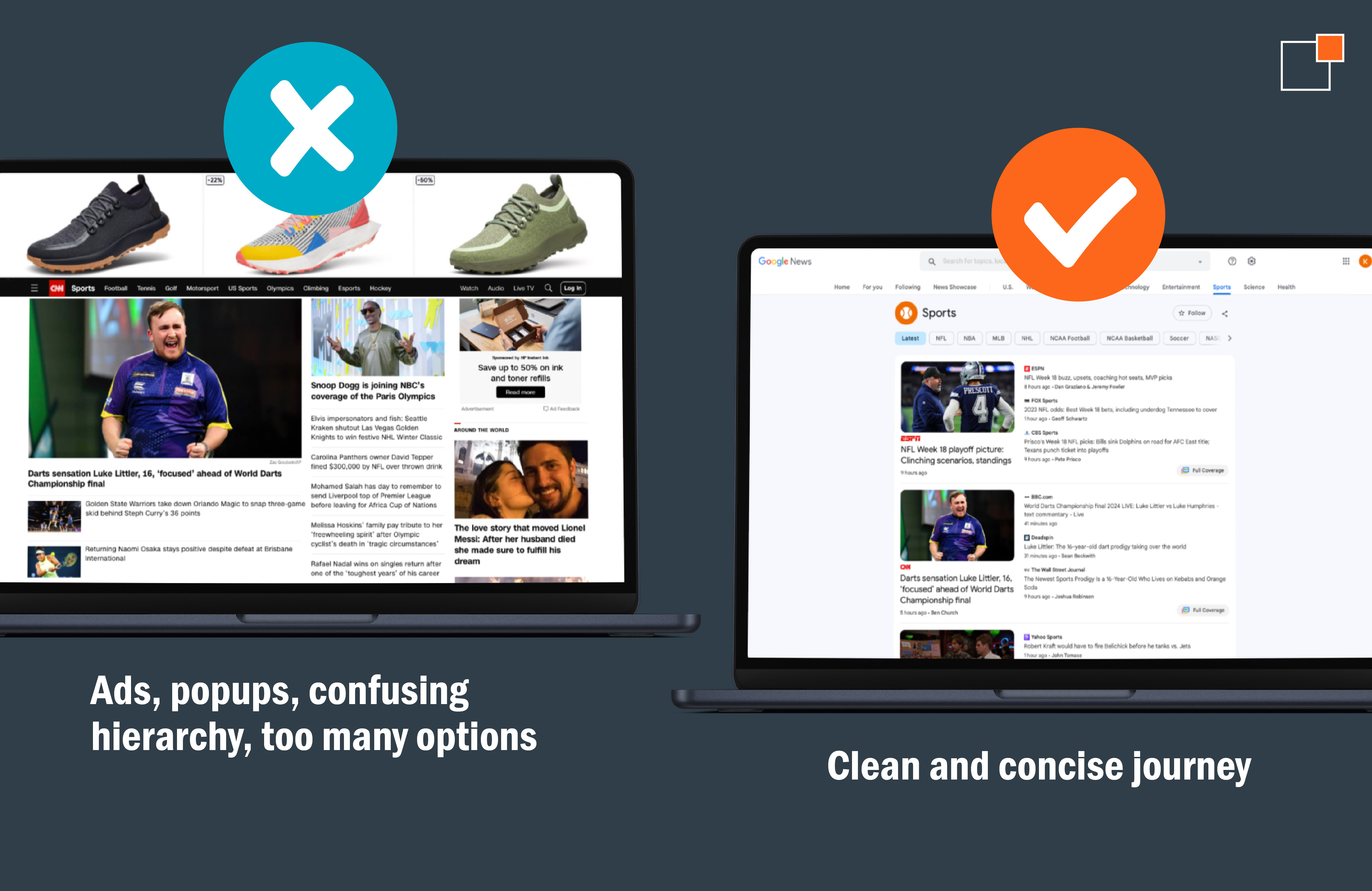Hot or Not? How to Be a Trendsetter in 2024
Digital marketing edition
Last year was truly remarkable, but we’re ready to take on 2024. To ensure we’re prepared to make this upcoming year even more impressive, we want to take a moment to look ahead at what the temperamental marketing landscape has in store for us.
Let’s dive into what trends are heating up and which should stay frozen in 2023.
HOT

Social Commerce
We're starting strong with a platform dominating our For You Pages - the TikTok Shop. You name it—crocheted tote bags, milk frothers, quirky t-shirts, sunrise alarm clocks, plant fertilizer, fidget rings, 3-D printed dragons—it's on TikTok Shop. From 2022 to 2023, the number of users who made purchases through TikTok jumped from 9.6% to 33.3%. The popularity and growth of TikTok Shop is proof that social commerce, the integration of eCommerce and social media platforms, is only going to grow.
Social commerce is shifting the way brands connect with consumers. It blurs the line between shopping and socializing, creating a dynamic space where consumers can discover, discuss and buy products within the same digital ecosystem. Thanks to social media, brands can connect with audiences already interested in their products by leveraging user-generated content (UGC), collaborating with influencers and offering personalized suggestions. 2024 is the year to get on the TikTok Shop and take advantage of the reach of social commerce.
Retro Nostalgia
Lately, we’ve seen the resurgence of trends from past decades—fashion from the 90s, mustaches from the 70s, vintage furniture from who-knows-when and more from every year in between. This revival of the past conjures a nostalgia that provides us with a sense of familiarity and comfort in a time of rapid technological advancement. Nostalgia has the power to evoke emotions and create a profound resonance with consumers. Data shows that more than half of adults in the U.S. are likely to purchase something that makes them feel nostalgic for the past.
Brands increasingly recognize the potential of weaving elements from the past into their marketing strategies, whether through retro design aesthetics, vintage-inspired campaigns or revisiting classic brand elements. We as humans crave a break from our modern, fast-paced lives while not wanting to completely give it up, so this year, we will continue to seek innovative products that blend modernity with charm from the past.

Social Media SEO
Along with social media’s growing commerce power, it’s also crucial to use it as a tool to boost your search engine optimization (SEO) value. Because social media platforms will continue to lead most online interactions, brands must optimize their social content for search engines to elevate their visibility. Social media SEO involves strategically aligning social media profiles, posts and content with relevant keywords and search queries.
Understanding the interconnectedness between social media and search engines has the ability to maximize reach. Not only should brands be enhancing their SEO value on social media for outside search engines, but they should also be aware of how their consumers search within a platform. Many users actually prefer using social media for searches rather than standard search engines like Google. In fact, 40% of Gen-Z users prefer using TikTok and Instagram as search engines instead of Google. Overall, this complicated relationship between social media and search engines will last, and it’s best to learn how to optimize it.
Long-Term Relationships with Influencers
In the year 2024, influencer marketing is not new. However, we encourage you to make the most of your relationships with your partnering influencers this year by reinforcing your commitment to your alliance. Instead of one-off collaborations, brands recognize the enduring worth of sustained partnerships with influencers who align with their values and target audience.
Influencers who show genuine excitement about the brand will ultimately help build trust and authenticity surrounding the brand with their audience. Nearly 70% of consumers say they are likely to trust a recommendation from an influencer—in addition to their family and friends—over information that comes directly from a brand. Many influencers have a long-term, devoted audience, and to have access to that audience, brands should build a similar lasting and enthusiastic relationship with their contributing influencers.

Integrating AI into Platforms
In 2023, we witnessed the popularity of artificial intelligence (AI) surge exponentially, and this year, the integration of AI will only continue to grow, especially in the world of social media and marketing. There are various AI tools that will help us do our jobs as marketers more effectively and efficiently, ultimately producing a better customer experience. Through AI image recognition, brands can generate text for images used in content that not only enhances accessibility but also works to optimize SEO performance.
Chatbots leveraging AI are also becoming more advanced and can build upon customer experience by providing real-time engagement and personalized support. In addition, marketers can use AI like Xperience to take a brand’s existing content (when organized into a hub) and generate content for emails, including subject titles. A more encompassing tool like Microsoft’s Azure OpenAI can do it all—content generation, summarization, image understanding, semantic search and natural language to code translation. The integration of AI not only amplifies the efficacy of platforms and creating content but also propels brands into a future of precision, personalization and productivity.

NOT

AI for Blog Writing
While AI has made significant strides in content generation, brands should exercise caution when considering AI for blog writing. Blog writing is an art as it requires human touch, creativity, empathy and a deep understanding of the target audience. It isn’t just about processing data and spitting out words, but rather about authentically connecting with your audience. Although AI is proficient in processing data and understanding language patterns, it will simply never fully be able to replicate the genuine voice and perspective of human beings and will ultimately leave you with writing that sounds generic and impersonal.
We don’t think you should use AI to write your brand’s blogs, but we do believe you can use it to help in the process of blog writing. AI can streamline this initial phase of outlining by taking our ideas and suggesting themes and key points that help organize our thoughts, leaving more time for us to focus on building our narrative and tone. In addition, AI can get us through writer’s block and offer inspiration by helping reword phrases we aren’t happy with and building on our pre-existing words. Moving forward, brands should find a balance between human creativity and AI assistance to maximize their blog writing.
Bulky Design & Aesthetic Overload
It’s important for your brand to show its unique personality and design, but don’t overdo it. Heavy design and too many visual elements can feel overwhelming and detract from overall functionality. Bulky design—incorporating excessive graphics, intricate animationsand convoluted layouts—tends to impede navigation and can even diminish loading speeds. Although aesthetics are undoubtedly crucial, overloading users with competing visual elements can result in clutter and confusion that inhibits the ability to easily access information.
Instead, we encourage you to keep it simple, sleek and intentional. You can still incorporate your brand’s personality while prioritizing a clean and intuitive user interface that enhances rather than hinders the user experience. To help establish a cohesive visual identity, use a consistent color palette, typography and imagery throughout your platforms. Integrate your brand's logo and key visual elements strategically without overwhelming the layout. Users will appreciate a platform that is functional with intentional design elements that do not distract from overall content.

Too Many Features
It’s true when they say you can have too much of a good thing. The intention behind rolling out new features on your platform is to improve the user experience; being overwhelmed with too many features at once can actually produce the opposite effect. Like bulky design, having an excessive number of features can cause confusion, increase complexity and impede navigation. A platform dense with features can also distract from the primary purpose, causing frustration and disengagement.
Again, consumers favor platforms that are simple to use and easy to navigate. When considering adding new features to your platforms, prioritize quality over quantity. Avoid crowding your digital landscape by carefully selecting features one at a time that are intuitive. Each feature should have a clear purpose that streamlines the user’s experience.
Forgetting the Customer’s Story
We all love to talk about ourselves, but we’re not always the best listeners. Make the resolution of being a better listener this year and tone down the focus on your brand. Instead, shift your focus to the customer and listen to their story.
You can still have pride in your brand and show enthusiasm about your product; just be sure to include the consumer in the narrative. Centering the customer’s story brings more focus on how the product realistically fits into the customer’s life rather than simply highlighting product features. It's not just about what the product does; it's about how it enriches and enhances the customer's journey. Create a relationship beyond just buying and selling by telling a story that unites customer experience with brand identity.
Only Targeting the Most Popular Keywords
We’ve already established how important SEO value is, but be careful which ones you choose. Avoid making the common mistake of only using popular keywords in your content. Popular keywords and searches are competitive, and it’s easy for your content to get lost and never be seen if you only use the search terms that everyone else uses. For example, the search for “indoor plants” will yield a lot more broad results than the more specific search “low light indoor plants nontoxic to pets.” Using short phrases that aren’t very specific will decrease your chance of visibility overall.
Rather, be sure to include long-tail keywords with more specific phrases in your content to optimize your searchability. Although these searches are more explicit, they end up amounting to a large percentage of searches on Google. Also, using more particular keywords will make consumers more likely to trust your content as it specifically addresses their more distinct searches.
Cheers to Marketers Everywhere
We cannot wait to see how 2024 will shape the marketing world. With the current pace of technological advancements in AI and the ever-changing landscape of social media, trends are evolving rapidly. We will be sure to keep you updated on how to optimize your brand’s presence on all platforms as the year progresses!
Need help getting started on making this year the best? Please contact us, and we’ll help you kickstart this year’s journey of success!
About the Author
Lexie Febel is a Content and PR Coordinator at thunder::tech. Her favorite pastime includes being cozied up with her cats while getting lost in the pages of a compelling book.